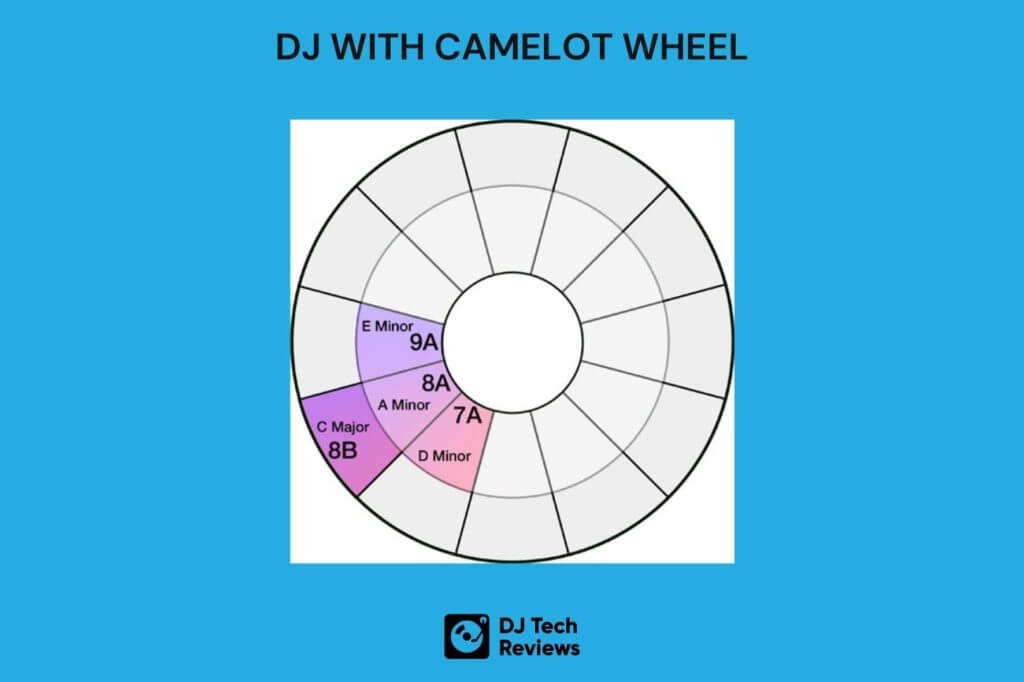If you’ve been involved with anything in the DJ space for a while, you’ll have probably heard of the term, “Camelot wheel” “harmonic mixing” or a “mix-in key” at least once. And, while neither term was ever particularly foreign, both have become much more commonly used today thanks to digital DJ controllers and DJ software. And, while the term “mix-in key” or mixedinkey.com is often used by DJs or in conversations about different controllers, it’s the fact that it is used with Camelot values and the Camelot wheel that make these features as useful as they are.
Derived from the circle of fifths, the Camelot wheel is a DJ controller tool that is used to better work out what songs go and don’t go together. Like the circle of fifths (which categorized songs via their notes), the Camelot wheel works by finding and cataloging specific songs that are of harmonic tonalities and don’t clash. It is because of this that DJs can perform harmonic mixing.
In this overview guide, we’ll go over what the Camelot wheel is as well as the circle of fifths. We’ll also get into how to use the Camelot wheel so that you can begin mixing different song elements like a DJ pro.
The Camelot Wheel vs. The Circle of Fifths – How Do They Differ?
As mentioned earlier, the Camelot wheel is directly pulled from the circle of fifths, the only difference being that the Camelot wheel comes with much easier key notations. While the circle of fifths would use the different piano key letter notes, the Camelot wheel would, instead, use numbers 1-12.
The Circle of Fifths Explained
Before we can truly get into the Camelot wheel, we’re going to first need to go over the circle of fifths to see how the method first originated.
As an octave is made up of 12 different parts (i.e., “pitches”), each piece was assigned a corresponding piano note: C, C#, D, D#, E, F, F#, G, G#, A, A#, B. The “#” notes were meant to describe the smaller black keys while the standard lettered notes were meant to describe the larger white keys.
What makes all of this so important is that, when combined, all of these notes work to create a musical system known as a “chromatic scale”. Musically, the odds of using all notes within the chromatic scale, when it comes to a specific song, are incredibly unlikely. Because of this, most songs today use what is known as a “diatonic scale”. The diatonic scale is noted for only keeping 7 of the 12 notes. Then, based on the 7 notes kept, a song is given a key signature. It’s actually why classical piano songs are given a letter and a major or minor title. For example, many classical songs will be listed as an “A-major” or a “C-minor”.
With the 7 retained notes, using the circle of fifths method, you can create around 24 different key signatures, all of which corresponding to either the 12 major or minor scales. These 24 different signatures can be played around with and arranged into a circle, creating the circle of fifths.

How The Circle of Fifths Operates
When on the circle of fifths, you start at the closest key signature on the circle with only one not being changed. As an example, a song that focuses on C-major will have the notes C, D, E, F, G, A, B, while the song that has a G-major will have the notes, G, A, B, C, D, E, F#, with only the “F” key changing. Because there was only one note that was changed (F to F#), both songs would have harmonically compatible key signatures.
The circle of fifths regards all key signatures that are closest to one another as being harmonically compatible. This is what makes it a great concept and method for mixing.
Another example of the different aspects of key signatures can be found between the C-major and A-minor notes. While the two share many of the same notes, because neither’s song structure uses the same combination of chords, they are considered to be two different key signatures. As such, even though they are virtually the same note, the C-major will have a happy-sounding tone while the A-minor will be a sadder and somber-sounding tone.
Mixing With The Circle of Fifths
While performing a mix, using the circle of fifths is a great way to play with the mood and setting of a situation. Particularly, changing from a major to a note’s minor is a great way to immediately change things from a happy tone to a sad tone, or vice-versa. This is because the notes that compose the song, while largely remaining identical, will dramatically shift in mood simply because of the slight change in notes.
The Camelot Wheel Explained
Whereas the circle of fifths is largely derived from the different notes, the Camelot wheel is much more easily accessible. This is because, while the notes can be somewhat confusing for non-piano players, the Camelot wheel’s number setting is much easier to utilize – the numbers following after each other along the circle.
Instead of following the piano notes, using the “#” to signify the minors, the Camelot wheel uses numbers along with either the letter “A” or “B” being used. For example, 6A is considered minor to 6B while 9A is minor to 9B. Here, all “A’s” are labeled as minor keys while all “B’s” are regarded as major keys.
Ultimately, while the circle of fifths was a great foundation, the Camelot wheel method is considerably easier to use for DJs, as the compatible key signatures follow each other as either a number or a letter.
How To Use The Camelot Wheel
There are many different ways to use the Camelot wheel based on how you plan to mix the song options.
Using The T-Method
One of the more popular methods is known as the “T-method”. This method consists of combining two key notes that are immediately adjacent to one another. Because these two keys are the most compatible harmonically, they will have the highest quality mix. If you want to increase the energy, you can add in a +2 from whatever Camelot value you are currently at.
As an example, while using the T-method with the Camelot wheel, if you picked a song with a 6B tone, the second song would need to have a tone that was either 6B as well, 6A, 7B, or 5B. If you wanted to give the mix an energy boost, you would instead choose for the second song to be 8B.
One thing you may have noticed about the different options was that, if you wanted, you could include another 6B-toned song. This is because the two would share the same notes and key signatures.
Determining A Song’s Key Signature
Now that you understand the underlying principles of the Camelot wheel, you’ll need to find out what your song’s key signature is. While you can guess it yourself, the most effective method of determining the song’s signature is through your DJ software. Generally, most software types come with a key detection algorithm that can determine what a song’s overall tone will be. If you don’t want to use that, you can also use an alternative application known as a “Mixed-In Key”.
How To Use Camelot Wheel [Simplified]
We’ve gone over the most fundamental aspects of what the Camelot wheel is as well as how to properly use it. To summarize, it breaks down into five simple steps:
- Analyze A Track Using DJ Software
- Sort Songs By Their Key Signatures
- Place A Key Lock On Your Decks
- Use Either The T-Method or the Energy Boost When Choosing The Next Song
- Trust Your Intuition

Challenges With The Camelot Wheel
While there are a lot of perks and benefits that can come from using the Camelot wheel, it isn’t a perfect system, nor does it manage to do everything right. Below are just a few of the different challenges that can occur when using the Camelot wheel and things to be on the lookout for.
#1. Inaccurate Key Detection Algorithm
One of the first areas you’ll need to be wary of is your software system’s key detection algorithm not accurately targeting a song. There are a few different reasons this can happen, ranging from a song not being in the diatonic scale to the key signature changing throughout the song, to even the algorithm itself being off.
By not having the key lock on, you potentially also run the risk of either slowing down or speeding up a song, altering its key signature.
#2. Mixing The Song At The Wrong Time
Another element that can lead to issues with the Camelot wheel is by choosing the wrong time to mix a song. Inopportune timing can result in a song mix not becoming harmonically compatible even if they otherwise would be.
Selecting your songs via the T-method is a great option as they can be mixed at virtually any point, creating a compatible matchup.
#3. Incompatible Tones When Boosted
This is more a result when using the energy boost method of mixing. If instead of using the T-method, you instead use the energy-boosting method, you run the risk of the two-song tones not completely being compatible. Luckily, the remedy for this issue isn’t too difficult.
To resolve this issue, either stick to intros and outros with the song mixing or instead choose your song’s phrasing better. By ensuring that neither song overlaps with one another, you can greatly improve the quality of the energy boost for your songs.
#4. Boring Sets
Lastly, if you are only mixing in songs with the same key signatures, you can often result in some very boring music sets. While these can certainly lead to some great and seamless transitions, because the songs will generally have the same tones, you can likely result in a fairly boring sound.
The best way to remedy this situation is by injecting a new key in it now and again. This ensures that the sound is much less monotonous while also making sure that they don’t overlap with one another, nor create any potential sound clashes.

Camelot Wheel: Summary
The Camelot wheel, both as an adaption of the previous circle of fifths as well as simply an effective way for determining key signatures and properly mixing them, is a great tool for any DJ to have. By understanding what the Camelot wheel is, and how to optimally use it (as well as some of the potential pitfalls to look out for) you can make some truly amazing sound DJ mixes that are both engaging as well as harmonic.




